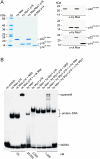Stem cell-specific activation of an ancestral myc protooncogene with conserved basic functions in the early metazoan Hydra
- PMID: 20142507
- PMCID: PMC2840113
- DOI: 10.1073/pnas.0911060107
Stem cell-specific activation of an ancestral myc protooncogene with conserved basic functions in the early metazoan Hydra
Abstract
The c-myc protooncogene encodes a transcription factor (Myc) with oncogenic potential. Myc and its dimerization partner Max are bHLH-Zip DNA binding proteins controlling fundamental cellular processes. Deregulation of c-myc leads to tumorigenesis and is a hallmark of many human cancers. We have identified and extensively characterized ancestral forms of myc and max genes from the early diploblastic cnidarian Hydra, the most primitive metazoan organism employed so far for the structural, functional, and evolutionary analysis of these genes. Hydra myc is specifically activated in all stem cells and nematoblast nests which represent the rapidly proliferating cell types of the interstitial stem cell system and in proliferating gland cells. In terminally differentiated nerve cells, nematocytes, or epithelial cells, myc expression is not detectable by in situ hybridization. Hydra max exhibits a similar expression pattern in interstitial cell clusters. The ancestral Hydra Myc and Max proteins display the principal design of their vertebrate derivatives, with the highest degree of sequence identities confined to the bHLH-Zip domains. Furthermore, the 314-amino acid Hydra Myc protein contains basic forms of the essential Myc boxes I through III. A recombinant Hydra Myc/Max complex binds to the consensus DNA sequence CACGTG with high affinity. Hybrid proteins composed of segments from the retroviral v-Myc oncoprotein and the Hydra Myc protein display oncogenic potential in cell transformation assays. Our results suggest that the principal functions of the Myc master regulator arose very early in metazoan evolution, allowing their dissection in a simple model organism showing regenerative ability but no senescence.
Conflict of interest statement
The authors declare no conflict of interest.
Figures





Similar articles
-
High Intrinsic Oncogenic Potential in the Myc-Box-Deficient Hydra Myc3 Protein.Cells. 2023 Apr 26;12(9):1265. doi: 10.3390/cells12091265. Cells. 2023. PMID: 37174665 Free PMC article.
-
Differential regulation of myc homologs by Wnt/β-Catenin signaling in the early metazoan Hydra.FEBS J. 2019 Jun;286(12):2295-2310. doi: 10.1111/febs.14812. Epub 2019 Mar 26. FEBS J. 2019. PMID: 30869835 Free PMC article.
-
Hydra myc2, a unique pre-bilaterian member of the myc gene family, is activated in cell proliferation and gametogenesis.Biol Open. 2014 Apr 25;3(5):397-407. doi: 10.1242/bio.20147005. Biol Open. 2014. PMID: 24771621 Free PMC article.
-
Structural aspects of interactions within the Myc/Max/Mad network.Curr Top Microbiol Immunol. 2006;302:123-43. doi: 10.1007/3-540-32952-8_5. Curr Top Microbiol Immunol. 2006. PMID: 16620027 Review.
-
The basic region/helix-loop-helix/leucine zipper domain of Myc proto-oncoproteins: function and regulation.Oncogene. 1999 May 13;18(19):2955-66. doi: 10.1038/sj.onc.1202750. Oncogene. 1999. PMID: 10378692 Review.
Cited by
-
Somatic polyploidy is associated with the upregulation of c-MYC interacting genes and EMT-like signature.Oncotarget. 2016 Nov 15;7(46):75235-75260. doi: 10.18632/oncotarget.12118. Oncotarget. 2016. PMID: 27655693 Free PMC article.
-
Proto-oncogenes in a eukaryotic unicellular organism play essential roles in plasmodial growth in host cells.BMC Genomics. 2018 Dec 6;19(1):881. doi: 10.1186/s12864-018-5307-4. BMC Genomics. 2018. PMID: 30522435 Free PMC article.
-
High Intrinsic Oncogenic Potential in the Myc-Box-Deficient Hydra Myc3 Protein.Cells. 2023 Apr 26;12(9):1265. doi: 10.3390/cells12091265. Cells. 2023. PMID: 37174665 Free PMC article.
-
2'-Azido RNA, a versatile tool for chemical biology: synthesis, X-ray structure, siRNA applications, click labeling.ACS Chem Biol. 2012 Mar 16;7(3):581-9. doi: 10.1021/cb200510k. Epub 2012 Jan 24. ACS Chem Biol. 2012. PMID: 22273279 Free PMC article.
-
The brain acid-soluble protein 1 (BASP1) interferes with the oncogenic capacity of MYC and its binding to calmodulin.Mol Oncol. 2020 Mar;14(3):625-644. doi: 10.1002/1878-0261.12636. Epub 2020 Jan 30. Mol Oncol. 2020. PMID: 31944520 Free PMC article.
References
-
- Bister K, Jansen HW. Oncogenes in retroviruses and cells: biochemistry and molecular genetics. Adv Cancer Res. 1986;47:99–188. - PubMed
-
- Eisenman RN. Deconstructing Myc. Genes Dev. 2001;15:2023–2030. - PubMed
-
- Nesbit CE, Tersak JM, Prochownik EV. MYC oncogenes and human neoplastic disease. Oncogene. 1999;18:3004–3016. - PubMed
-
- Dang CV, Kim JW, Gao P, Yustein J. The interplay between MYC and HIF in cancer. Nat Rev Cancer. 2008;8:51–56. - PubMed
Publication types
MeSH terms
Substances
Associated data
- Actions
- Actions
- Actions
Grants and funding
LinkOut - more resources
Full Text Sources
Medical

